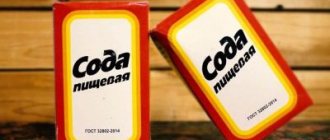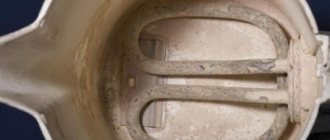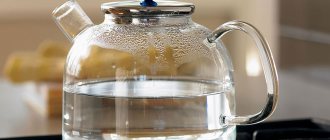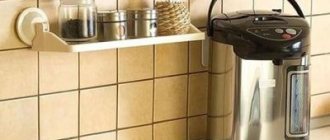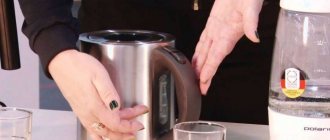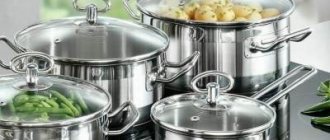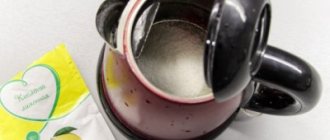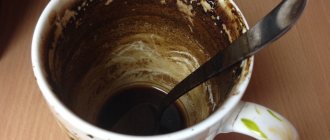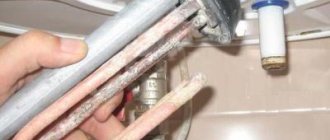/Order/
In any water heating device from time to time we discover a treasure trove of minerals, namely deposits of magnesium and calcium salts from hard water. And if we always try to prevent the occurrence of scale in the dishwasher and washing machine, then what can we say about the kettle, where it not only impairs its performance and leads to breakdowns, but also harms the health of household members.
In this material, we have collected 6 of the most effective and affordable methods at home that will help you descale your kettle. In fact, the secret of all folk remedies is very simple:
- Scale in a kettle or electric kettle is afraid of organic and inorganic acids, so almost all methods of removing it at home are based on the use of acid-containing products.
See also the material: How to clean the iron inside and outside - 10 home methods.
Why does it work
Arina Piskareva
Laboratory employee, Department of Bioengineering, Moscow State University
Scale is mainly composed of calcium and magnesium carbonate. When interacting with citric, acetic, orthophosphoric or other acid, sparingly soluble carbonates of alkaline earth metals are converted into readily soluble salts. For example, acetates. Therefore, acidic substances are effective in the fight against scale, and to enhance the reaction they need to be heated.
Soda, when interacting with water, produces carbonic acid molecules, which, in turn, react with insoluble calcium and magnesium carbonates, turning them into soluble bicarbonates. And they are easily washed off with water and removed with a sponge.
Can it be cleaned?
You can clean the kettle with citric acid. The layer that forms inside is salt deposits. They no longer dissolve in ordinary water. To destroy their hard shell, exposure to more aggressive substances is necessary.
Citric acid is the most accessible, safe and inexpensive remedy that helps to quickly cope with the problem. You can clean the kettle with lemon. It does not harm its walls, does not cause them corrosion or oxidation.
The preservative works exclusively on the surface, dissolving solid deposits. In the future, you can use such a device without danger to your health.
How to descale with citric acid
- Suitable for any kettles, coffee machines, irons, washing machines.
- Proportions : teapots, coffee machines and irons - 10 g for every 100 ml of water; washing machines - 50 g per kilogram of load.
- Pros : environmentally friendly, safe, affordable, pleasant aroma.
- Cons : does not cope with old, thick scale.
How to descale a kettle
Fill the kettle about ¾ full with water, so that the liquid covers the deposits on the walls and heating elements, but does not splash out when boiling.
Pour citric acid into a kettle (100 g of powder for every liter of water) and boil.
Leave until completely cool. Drain the water, remove any remaining plaque with a sponge and wash thoroughly.
How to descale a coffee machine
For a coffee machine, it is necessary to prepare a solution of citric acid based on the volume of the water reservoir. For example, if the coffee machine is designed for 2 liters, you will need 200 g of citric acid.
Pour the hot solution into the tank and leave for 60 minutes.
After an hour, start the coffee program without the coffee itself. Drain the liquid through dispensers.
Then run the coffee machine with only water, without citric acid. As soon as you pour out the boiling water, you can use the device. If the coffee machine reservoir is removable, remove any remaining deposits under running water.
How to descale your iron
Prepare a solution for the iron: add 10 g of citric acid for every 100 ml of boiling water, stir and cool to room temperature. Remove the anti-lime rod, if present, and soak in the resulting solution for an hour.
If not, pour the solution into the water tank. Turn on the iron and, holding it vertically, release steam until all the liquid is used up. It is better to do this over a bathtub or basin: along with the steam, scale will fly out of the holes in the sole.
After the procedure, rinse the iron reservoir with running water and wipe the sole with ammonia or nail polish remover.
How to descale your washing machine
To remove plaque from the heating elements and drum of the washing machine, you will need 50 g of acid per kilogram of load.
Place ¾ citric acid (190g acid per 5kg load) into the powder tray and ¹⁄₄ (60g) directly into the drum. Run the wash at maximum temperature.
Preventing the formation of limescale
Practice shows that scale forms when using any water. However, there is always the opportunity to slow down this process and make cleaning the kettle a rarer and easier procedure.
To do this, it is recommended to use purified water for boiling. It contains less salts. In addition, it is very useful to let the water stand for 24 hours. It is also advisable not to leave unused water in the kettle and pour it out immediately after drinking tea.
The walls of the device must be regularly wiped with a soft, soapy sponge . This helps in time to remove the salt layer that has not yet stuck to the surface.
When purchasing a new kettle, it is recommended to give preference to modern models in which the heating element is coated with a special material. It prevents excessive scale deposits and thereby protects the boiler from damage and increased energy consumption.
How to descale with table vinegar
- Suitable for glass and ceramic teapots, stainless steel kettles, irons and washing machines.
- Proportions : teapots - 100 ml for each liter of water; irons - 1 tablespoon per liter of water; washing machines - 10 ml per kilogram of load.
- Plus : a more aggressive acidic environment removes even a thick layer of scale.
- Cons : may harm rubber and plastic elements of devices, pungent odor.
How to descale a kettle
To clean the kettle, dilute vinegar in water and place on fire. After boiling, let it simmer for a few more minutes. Then drain the water, remove any remaining deposits with a sponge and cleaning agent, and boil clean water in a kettle.
How to descale your iron
Pour the warm vinegar solution into the water reservoir and, holding the iron horizontally, release the steam.
Boil a kettle of vinegar and release steam from the iron only in a well-ventilated area.
How to descale your washing machine
In the washing machine, pour vinegar (10 ml per kilogram of load) into the cuvette for conditioner or liquid powder. Run the wash without laundry at maximum temperature, and then rinse again to be sure to get rid of the specific aroma.
Vinegar can damage the rubber bands on the door, so be careful if you decide to pour the product directly into the drum. This can be done when there are no liquid reservoirs in the machine.
Filters for water
To prevent the appearance of scale in everyday life, filtration systems are used. They produce different types of devices, from simple jugs to technologically advanced reverse osmosis systems. Each method has its own characteristics, so when choosing, you need to take into account the specifics of the model, efficiency, practicality, and cost.
Filters:
- jug. The most famous brands are Aquaphor, Barrier, Sibir Tseo, Geyser, Brita Marella. They are convenient to use in the kitchen, apartment, or country house (if there is hard water in a well or borehole). The cleaning speed with funnels is one and a half liters in about 7-10 minutes. The replacement cartridge is designed for 3 months. Removes unpleasant odors, improves taste, cleanses from impurities;
- attachment on the crane. In addition to unpleasant odors, it removes chlorine and rust. Depending on the model and water quality, the cartridge is changed every 6 months or once a year. Filling - 2 minutes. Brands - Aquaphor;
- flow filter. Several stages of cleaning. When using special softening cartridges, it reduces the amount of salts. Used for water of medium hardness. Replaceable modules last up to a year. Example - Atoll STD - flow-through under sink, 5 stages;
- reverse osmosis system. Complete cleansing. Removal of nitrates and pesticides. Protection against viruses and bacteria. Softens water, eliminates the appearance of limescale in teapots. The module with the membrane is changed every 2 years, cartridges - every 2 months.
The most reliable and effective option is to install a reverse osmosis system with special cleaning modules. They are based on the availability of space in the room, filtration speed indicators, maintenance costs, and the number of users.
If the water is of high hardness, then it is advisable to install modern filters rather than constantly cleaning the kettle and other kitchen appliances from scale.
How to clean scale with soda
- Suitable for any teapots, coffee machines.
- Proportions : teapots and coffee machines - 1 tablespoon for every 500 ml of water.
- Pros : accessibility, simplicity.
- Cons : does not remove all types of plaque, does not cope with old deposits.
The mechanism for cleaning teapots and coffee makers with soda is simple: fill them with water, add soda and boil. In this case, it is recommended not to remove a regular kettle from the heat for another 20–30 minutes after boiling, and to turn on an electric kettle several times.
After the procedure, wash the inside of the kettle or coffee machine reservoir and boil clean water.
If the plaque is very strong, try a more alkaline soda ash instead of baking soda. Or add the same amount of salt to regular soda.
How can you remove thick, old plaque?
If a thick lime layer has formed on the walls of the heating device, the cleaning procedure must be repeated twice or three times. After each cleaning, the kettle is rinsed and a new portion of water and cleaning agent is poured.
In some cases, it is advisable to increase the dose of the cleaner. The only exception concerns soda, which in excess can increase the volume of boiling liquid.
You can also enhance the result by simultaneous combination of cleansers . For example, citric and oxalic acids can be used in pairs.
Ready-made household chemicals are the most active, and among home remedies - organic acids (citric, acetic) and baking soda. Natural cleansers (sorrel leaves, lemon, cucumber pickle) cope with the difficult task weaker and slower.
How to descale with soda water
- Suitable for any teapots, coffee machines, irons.
- Proportions : the vessels are filled approximately ¾.
- Plus : effective even with thick plaque.
- Disadvantage : a colored drink may stain the vessel. Therefore, to clean irons and white plastic electric kettles, it is better to use clear soda, including mineral water.
How to descale a kettle or coffee machine
Open the bottle and wait until most of the carbon dioxide has evaporated.
Pour the soda into the kettle or coffee maker reservoir, hold for 15–20 minutes, and then boil.
Thanks to phosphoric acid and carbon dioxide, sodas do an excellent job of removing salt deposits.
How to descale your iron
Pour the soda into the water reservoir, turn on the appliance, hold the iron vertically and release steam. If there is a lot of scale, do this several times.
Special means
The chemical industry has developed special formulas for easy softening and descaling. These are, for example, Cinderella, Antiscale, Flat, Bosch and many others.
They are easy to use: in most cases, you need to dissolve the product in water, boil and leave for some time.
Please note that some formulas have a different method of application. Be sure to read the instructions!
How to clean scale with brine
- Suitable for any teapots.
- Proportions : the kettle must be filled ¾ full.
- Pros : simplicity, accessibility.
- Cons : does not cope with persistent plaque, specific smell.
The brine contains lactic and acetic acids. Fill the kettle with strained cucumber or tomato brine and boil for 20–30 minutes.
After this, drain the brine and scale and wash the kettle with a soft sponge and cleaning agent.
Helpful information
To ensure that the procedure for removing lime deposits is effective and safe for health, you need to follow simple rules:
- You should not drink water from the kettle immediately after the procedure. First you need to boil it with clean water and drain it. Only after this can the device be fully used.
- All household members should be warned that the kettle is filled with descaling liquid. This will avoid poisoning.
- Once the cleaning solution boils, do not immediately pour it into the sink. The longer it stays inside, the higher the cleaning efficiency.
You can learn about methods and methods for descaling here.
How to clean scale with soda, citric acid and vinegar
- Suitable for any teapots.
- Proportions : 1 tablespoon of soda, 1 tablespoon of citric acid and a glass of vinegar per liter of water.
- Plus : even breaks up rock salt deposits.
- Disadvantage : troublesome, strong smell, exposure to aggressive components on devices.
Fill the kettle with water, add soda and citric acid and boil. If the kettle is electric, do this 2-3 times. If regular, let the lemon soda solution bubble for 20-30 minutes.
Drain and refill the kettle with water. Boil it and pour in vinegar. Leave for 15–20 minutes.
If after this the scale does not come off on its own, it will become loose. You can easily remove it with a sponge and dishwashing detergent.
At the end, boil clean water in the kettle again and then drain it.
Reviews
Catherine:
My grandmother taught me how to clean a kettle from plaque with citric acid. Everything sparkled on her, despite the fact that the water was hard, and whitish stripes immediately remained everywhere in the ladle, on the walls of the tank. She did not delay the cleaning and often boiled water with acid powder. I adopted the method, it turns out cheap and effective. I use it in a plastic teapot and take a small amount of powder. I boil it and then wipe it with a cloth.
Ivan:
A good way to clean a kettle, or any other utensils. Eats away all the layers. If they are old, then you need to hold the solution longer or boil it again. I also pour the solution into enamel pans if the deposit is small. I haven’t encountered severe scale, I try not to let it get to that point. I usually do prophylaxis once a month, and everything is fine.
It’s easy to clean even the oldest scale if you have citric acid on hand. It is enough to make the solution in the required proportion, follow the steps consistently, and the kettle will regain its former luster and cleanliness.
Features of cleaning electrical appliances made of different materials
Depending on the material from which the kettle is made, the rules for cleaning it will differ.
Basic moments:
It is not recommended to use Coca-Cola or Fanta for plastic cutlery. These drinks contain dye that can be absorbed into the walls when heated, which will not have the best effect on the appearance of the device.- Kettles made of aluminum, copper, brass and galvanized metal are afraid of contact with acids. Therefore, it is better to use gentle products to clean them.
- It is not recommended to rub glass teapots with a wire brush to avoid scratches.
- Metal devices are afraid of contact with sharp objects.
